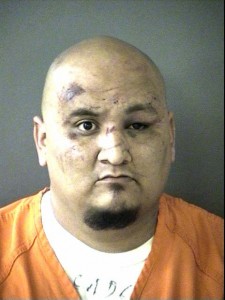
A one and a half year investigation ended with the arrest of more than 20 individuals suspected of having ties to a violent gang on Friday in Seguin, Texas, a town located roughly 50 miles south of Austin. The suspects apprehended are believed to be associated with the Texas Mexican Mafia, also referred to as the Mexikanemi, started by San Antonio native Herb Huerta in a Texas prison in the 1980s.
Huerta initially created the gang in an effort to protect Mexican and Hispanic families being targeted by another gang called the Texas Syndicate, but it soon turned “predatory,” dabbling in drug trafficking, robberies, and murder, according to local news outlets.
The raid employed around 150 police officers from local, state, and federal law enforcement, who describe the alleged gang members as “treacherous” and “violent,” reports KXAN. Some of those arrested on Friday had received prior murder convictions.
Among those apprehended include the gang’s purported leader. Additional arrests were executed in New Braunfels, San Antonio, and Houston, with the suspect’s ages ranging from 23 to 50 years old. During the bust, police uncovered a host of cash, weapons, drugs and vehicles that law enforcement later seized.
Trafficking drugs from Austin to Houston
“The amount of money we seized we can’t count that by hand. We have a machine counting it right now,” said Seguin Deputy Chief Bruce Ure. “This will make a big dent in the Texas Mexican Mafia,” he added.
“The problem with gangs, is that every gang that you take down, there’s 10 more people that are willing to step up and take over. But when they do, if you’re in this region, if you’re the next 10, we’re going to take you down too. And then the next 10 that step up, we’re going to take them down as well,” Ure told the media.
Members of the Texas Mexican Mafia “have a history of robbery” and “aggravated assault on a police officer,” said Austin Police Chief Art Acevedo in 2011.
The Texas Mexican Mafia is notorious for trafficking drugs along the Austin/Houston corridor and is thought to still have ties to the Texas prison system. Though the gang’s creator remains in solitary confinement 23 hours a day inside a federal prison in Colorado, he maintains control of Mexikanemi.
In October of last year, My San Antonio Express News reported on the arrest of an alleged hit man working for the Texas Mexican Mafia. Ruben “Menace” Reyes, 36, told U.S. District Judge David Alan Ezra he was involved in 16 gang-related murders. Police suspect that number is nearly double.
Among the killings Reyes admitted to having involvement include fellow gang members and a police officer. He’s also suspected of being involved in the murder of Julie Ann Rodriguez, 44, who was set to testify in court as a key witness against the gang’s “captain of captains.”
Rodriguez was found shot in her driveway in September 2013 one day prior to her scheduled testimony.
Aztec and Mexican culture beliefs
The Texas Mexican Mafia is deeply rooted in Aztec and Mexican culture, worshipping gods and believing its members are modern day warriors.
“They consider San Antonio to be the capital of Aztlan, which is the homeland of the Aztecs before they went to Mexico City and started their empire,” said Gabe Morales, a prison gang expert.
“They use that as a recruitment tool for younger members, to say, ‘If you’re proud of your heritage, proud of the Aztec empire, we’re going to bring a modern day empire back. If you join our organization, the Texas Mexican Mafia, then you’ll be a part of it and you’ll get to share in all the fruits of our labor.'”
Gang member tattoos reflect their beliefs. “The regional estampa, a symbol of the Texas Mexican Mafia, was the eagle and serpent on a cactus, which is the symbol that you see on the Mexican flag,” Morales said.
“They also have daggers. The daggers aren’t quite accurate because the Aztecs used obsidian stone and not steel daggers, but you’ll see crossed daggers, often with the eagle and the serpent. Above that is a Quetzalcoatl, often the double-headed serpent, above that in the form of an M.”
Sources:


